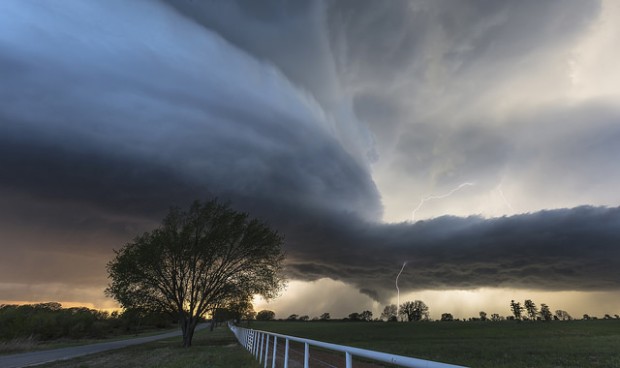Drier, Hotter, More Extreme Weather: How Climate Change is Already Affecting Oklahoma
-
Joe Wertz
A new federal report bluntly warns that every region of the United States is already observing climate change-related effects to the environment and economy.
In Oklahoma and other Great Plains states, climate change from carbon emissions is changing crop growth cycles, increasing energy and water demand, altering rainfall patterns and leading to more frequent extreme weather and climate events, the report concludes.
The magnitude of those changes is expected to increase throughout Oklahoma’s region, according to the report. And researchers say current planning efforts to respond and adapt to climate change are “inadequate.”
More than 300 experts contributed to the National Climate Assessment, which took three years to compile and was reviewed by a panel of the National Research Council and the National Academy of Sciences.
Explaining the report’s findings on a conference call with reporters, Katharine Hayhoe, an associate professor at Texas Tech University and director of the school’s Climate Science Center, said climate change is a “present reality” for Oklahoma and its seven regional neighbors.
“It’s no longer an issue that’s distant in time and space that matters only to the polar bears in the arctic or to our children, or their children,” she says. “It’s affecting us today. It’s affecting Americans across the country, it’s affecting people around the world, and it is affecting us here in the Great Plains.”
The full report is available here, but the most pertinent analysis to Oklahoma is contained in the Great Plains chapter, which is embedded above. Eight scientists contributed to this chapter, including two from the University of Oklahoma.
Here are the bullet points for climate change effects in the Great Plains:
1. Greater Water, Energy and Land Use
Water, energy and land are inseparable, a theme that has emerged in previous reporting here at StateImpact. Many states in the region — Oklahoma, Texas, North Dakota and Wyoming — are big oil, natural gas and coal producers. But 80 percent of the land in the region is still used for agriculture, according to the report. The demands of energy and agriculture, combined with drought, are increasing competition for water.
The trend toward more dry days and higher temperatures across the south will increase evaporation, decrease water supplies, reduce electricity trans- mission capacity, and increase cooling demands. These changes will add stress to limited water resources and affect management choices related to irrigation, municipal use, and energy generation.
2. Crops and Livestock Are Susceptible
Crops are adapting to warmer temperatures and different rainfall patterns, which affects productivity. A possible benefit could be a longer growing season in some Great Plains states, but warmer winters mean more pests and invasive species, the report concludes. And more intense rainfall events lead to more erosion and nutrient runoff. In the south and central plains states like Oklahoma, aquifer depletion could limit agriculture:
Holding other aspects of production constant, the climate impacts of shifting from irrigated to dryland agriculture would reduce crop yields by about a factor of two. Under these climate-induced changes, adaptation of agricultural practices will be needed, however, there may be constraints on social-ecological adaptive capacity to make these adjustments
3. This Land is Getting Fragmented
In Oklahoma, the wind and oil boom in western and northwestern Oklahoma have helped fragment the landscape. This, combined with warmer temperatures and drought, has had a big impact on wildlife like the Lesser Prairie Chicken, which goes on the federal threatened species list on May 12.
Oklahoma and other states have developed conservation plans for grasslands and prairie wildlife, but the report forecasts long-term difficulty.
… climate change will complicate current conservation efforts as land fragmentation continues to reduce habitat connectivity.
4. Some People Face a Greater Risk
The report points out the geographic, economic and cultural diversity of the people who live in the Great Plains, but warns that many communities — particularly Native Americans, those in remote or sparsely populated areas, or those with language barriers or limited access to services — face a particular challenge in responding to climate extremes.
Populations such as the elderly, low-income, and non-native English speakers face heightened climate vulnerability. Public health resources, basic infrastructure, adequate housing, and effective communication systems are often lacking in communities that are geographically, politically, and economically isolated. Elderly people are more vulnerable to extreme heat, especially in warmer cities and communities with minimal air conditioning or sub-standard housing. Language barriers for Hispanics may impede their ability to plan for, adapt to, and respond to climate-related risks.
Native Americans face unique climate challenges, too:
While tribal communities have adapted to climate change for centuries, they are now constrained by physical and political boundaries. Traditional ecosystems and native resources no longer provide the support they used to. Tribal members have reported the decline or disappearance of culturally important animal species, changes in the timing of cultural ceremonies due to earlier onset of spring, and the inability to locate certain types of ceremonial wild plants.
5. Our Governments’ Plan is Inadequate
Water wars in Southern Plains states — that’s Oklahoma — are expected to strain resources in “already stressed” systems, which will likely impact agriculture and energy production, and how the sub-region’s animals, plants and people thrive, the report’s researchers conclude.
State, local and tribal planning efforts to adapt and plan “do not match the magnitude of the expected changes,” according to the report:
Although there is tremendous adaptive potential among the diverse communities of the Great Plains, many local government officials do not yet recognize climate change as a problem that requires proactive planning.60,65 Positive steps toward greater community resilience have been achieved through local and regional collaboration and increased two-way communication between scientists and local decision-makers

